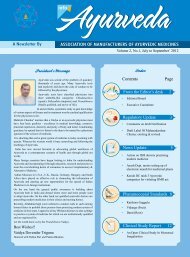Wishing You Happy Dhanwantari Jayanti Happy Diwali & A ...
Wishing You Happy Dhanwantari Jayanti Happy Diwali & A ...
Wishing You Happy Dhanwantari Jayanti Happy Diwali & A ...
You also want an ePaper? Increase the reach of your titles
YUMPU automatically turns print PDFs into web optimized ePapers that Google loves.
HEAVY METALS CONTENTS IN AYURVEDIC<br />
PRODUCTS<br />
Question: Will the Minister of Health And Family Welfare be pleased to<br />
state: -<br />
(a) Whether the level of lead, mercury and arsenic in some of the ayurvedic<br />
products exported by the Indian manufacturers has been found beyond<br />
the permissible limit;<br />
(b) if so, the details thereof and the response of the Government thereto;<br />
and<br />
(c) the steps taken by the Government in this regard?<br />
Answer: The Minister Of State For Health & Family Welfare (Smt.<br />
Panabaka Lakshmi)<br />
(a), to (c) The permissible level of lead, mercury and arsenic in Ayurvedic<br />
products as per WHO standards, which has been acceptable by the<br />
Department is 10 ppm, 1 ppm and 3 ppm respectively.<br />
As per the article published in Journal of American Medical Association<br />
(JAMA) dated 27th August 2008, one fifth of the Indian manufactured<br />
Ayurvedic products bought on the Internet contain detectable levels of lead,<br />
mercury and arsenic. After the report is published, Government has taken<br />
immediate steps to test the reports appearing in JAMA article by reputed<br />
and accredited laboratories. Central Council for Research in Ayurveda and<br />
Siddha (CCRAS) has also undertaken a study to test the toxicity/safety<br />
profile of metal-based bhasmas. The study is jointly being carried out with<br />
the Industrial Toxicology Research Center (ITRC), Council for Scientific<br />
and Industrial Research (CSIR), Lucknow. Pharmacopoeial Laboratory of<br />
Indian Medicine (PLIM), Ghaziabad has also been directed to procure<br />
samples of all the products mentioned in JAMA article and send them<br />
to Indian Institute of Chemical Technology (IICT), Hyderabad for heavy<br />
metal analysis by electron spectroscopic chemical analysis as well as<br />
X-ray flourescence spectroscopy.<br />
The manufacturers of Ayurvedic medicines have been directed to get safety/<br />
toxicity studies carried out for their products by National Accreditation<br />
Board for Testing and Calibration Laboratories / Good Laboratories<br />
Practices (NABL/GLP accredited laboratories and send their report in<br />
respect of acute, sub acute and chronic safety/toxicity drugs studies.<br />
After examination it is found that no exported herbal ayurvedic medicine<br />
from India contain heavy metals beyond the permissible limit. As far as<br />
purely herbal Ayurvedic formulations are concerned presence of heavy<br />
metals is not detected. As regard herbo-mineral and herbo- metallic<br />
preparations metals are an essential ingredient of these formulations and<br />
therefore are bound to be present in these, however they are permitted<br />
to be used only after due purification and only in small quantities to act<br />
as catalysts for activation of other herbal ingredients in order to increase<br />
the efficacy of the medicines. The metallic preparations in the form of<br />
compounds of metals triturated in the form of Bhasmas are rendered safe<br />
after purification with herbs and burning in fire for a prescribed number<br />
of times.<br />
# A Press release was issued on 2nd September, 2008 with detailed<br />
comments by the Department of AYUSH, after article published in JAMA<br />
(U.S.) 27th August, 2008 alleging heavy metals in Ayurvedic medicines.<br />
# The following other necessary orders have also been issued by the<br />
Central government to ensure safety and efficacy of AYUSH products in<br />
the country and abroad.<br />
• Government has introduced mandatory testing for heavy metals in all<br />
purely herbal Ayurveda, Siddha and Unani medicines to be exported<br />
with effect from 01.01.06 onwards. This has been done to meet the<br />
regulatory requirements of importing countries.<br />
• State Drug Licensing Authorities have been directed to ensure full<br />
compliance by all ASU drug manufacturers of the provisions of Rule<br />
161 (1) and (2) relating to displaying on the label of the container or in<br />
a leaflet to be inserted in the package of an ASU drug, the true list of<br />
all the ingredients used in the manufacture of the preparation together<br />
with the quantity of each of the ingredients incorporated therein.<br />
• A research project has been sanctioned to various laboratories of<br />
Council of Scientific and Industrial Research (CSIR) under the Golden<br />
Triangle Partnership Project to study the physiochemical characteristics<br />
of 8 most widely use Bhasmas and to carry out their toxicity studies.<br />
• Good Manufacturing Practices have been made mandatory for all<br />
Ayurveda, Siddha and Unani drug manufacturing units in the country.<br />
• Department of AYUSH has discussed with Minister of Commerce to<br />
set up an AYUSH Export Promotion Council under the Department of<br />
AYUSH to take care of critical issues like testing and certification of<br />
Ayurveda, Siddha and Unani medicines for export.<br />
• Govt. have constituted Pharmacopoeia Committees of Ayurveda, Siddha<br />
and Unani systems of medicines for preparation of Pharmacopoeias to<br />
ensure the quality of Ayurveda, Siddha and Unani drugs.<br />
• Captain Shreeniwasmurti Drug Research Institute for Ayurveda,<br />
Chennai, India Toxicology Research Centre (presently IITR, Indian<br />
Institute of Toxicology Research), Lucknow and Sri Ram Institute<br />
for Industrial Research, New Delhi have analyzed about 600 plants<br />
and it was found that lead arsenic and mercury levels were within the<br />
permissible limit.<br />
• State Licensing Authorities have been directed to constitute an Expert<br />
Committee under the provision of Rule 154 (2) of the Drugs and<br />
Cosmetics Rule, 1945 for streamline the system for licensing of patent<br />
and proprietary Ayurveda, Siddha and Unani products.<br />
MEDICINAL PLANTS ON THE VERGE<br />
OF EXTINCTION<br />
Question: Will the Minister of Health And Family Welfare be pleased to<br />
state: -<br />
(a) Whether the Medicinal Plants are on the verge of extinction;<br />
(b) if so, the details thereof and the reasons there for; and<br />
(c) the steps taken by the Government in this regard?<br />
Answer: Minister of State in the Ministry of Health and Family Welfare<br />
(Smt. Panabaka Lakshmi)<br />
(a) & (b): No, Sir. However, the medicinal plants, like other groups of<br />
plants and animals, are threatened largely due to degradation of forests<br />
owing to various anthropogenic factors.<br />
(c): The Ministry of Environment & Forests formulates policies for<br />
protection of forests. The Indian Forest Act, 1927 and the Wild Life<br />
(Protection) Act, 1972 have provisions for protection of forests and<br />
wildlife, including medicinal plants. The National Biodiversity Act,<br />
2002 regulates the access to forest resources, including medicinal plants.<br />
The Ministry of Environment & Forests is also supporting a number of<br />
projects on conservation by setting up Medicinal Plants Conservation<br />
Areas (MPCAs) that are primarily located in forest areas. Plantation of<br />
medicinal plants in degraded forest lands is supported through schemes of<br />
the National Afforestation & Eco-development Board (NAEB), Ministry<br />
of Environment & Forests.<br />
Government has also set up Medicinal Plants Board to coordinate matters<br />
relating to medicinal plants with Ministries/ Departments and other<br />
stakeholders for ensuring availability of medicinal plants of quality to the<br />
industry on a sustained basis.<br />
The Board has undertaken various programmes for conservation and<br />
development of medicinal plants. Central assistance is provided under the<br />
following schemes:<br />
i) “Central Sector Scheme for Conservation, Development and<br />
Sustainable Management of Medicinal Plants”<br />
The activities for which assistance is provided are as under:<br />
• Survey, Inventorisation and in-situ conservation of rare, endangered<br />
and threatened species of medicinal plants and setting up Medicinal<br />
www.amam-ayurveda.org 4


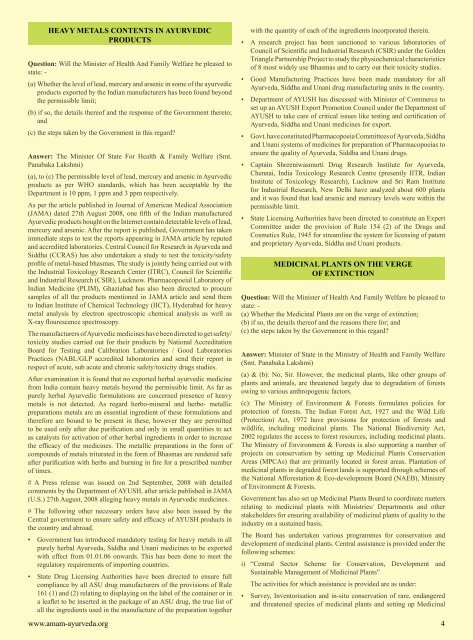

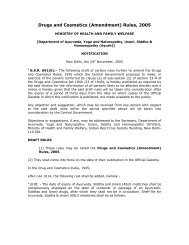
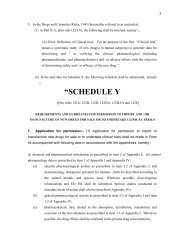
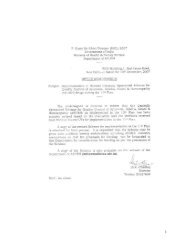

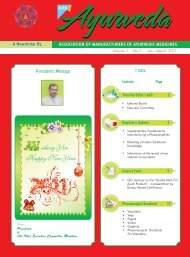

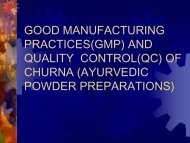
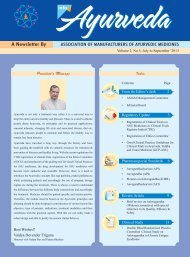
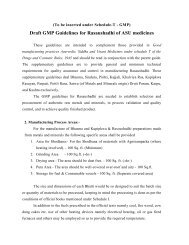
![[To be published in Gazette of India Part II Section 3, sub-section iii]](https://img.yumpu.com/28570283/1/190x245/to-be-published-in-gazette-of-india-part-ii-section-3-sub-section-iii.jpg?quality=85)

